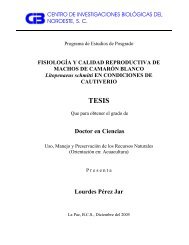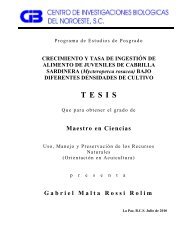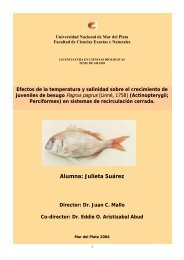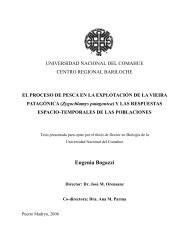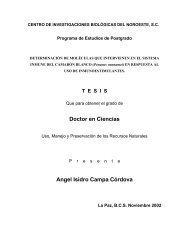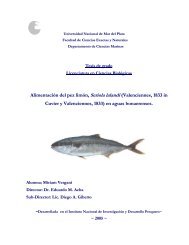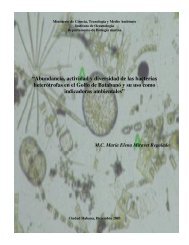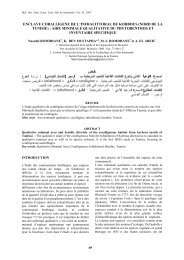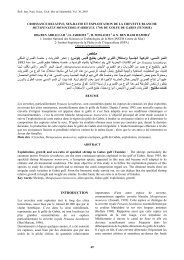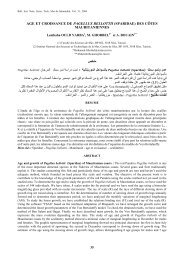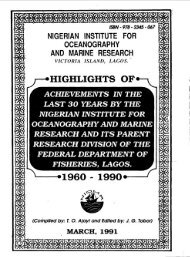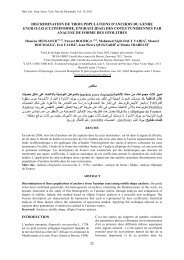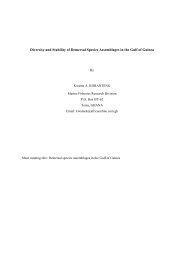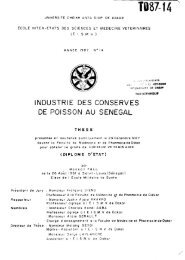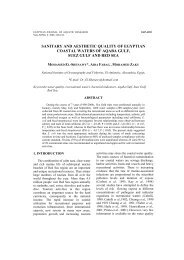Coastal vulnerability, resilience and adaptation to ... - OceanDocs
Coastal vulnerability, resilience and adaptation to ... - OceanDocs
Coastal vulnerability, resilience and adaptation to ... - OceanDocs
You also want an ePaper? Increase the reach of your titles
YUMPU automatically turns print PDFs into web optimized ePapers that Google loves.
proaches (e.g., Harvey et al., 1999), culminating in the emergence of the concept of “adaptive<br />
capacity” (see Sections 4.3 <strong>and</strong> 6.2).<br />
Before climate change emerged as an academic focus in coastal research, <strong>vulnerability</strong><br />
as such was not an important concept. Traditional research in coastal zones is conducted<br />
mainly by geologists, ecologists <strong>and</strong> engineers, roughly as follows:<br />
Geologists study coastal sedimentation patterns <strong>and</strong> the consequent dynamic processes<br />
of erosion <strong>and</strong> accretion over different spatial <strong>and</strong> temporal scales;<br />
Ecologists study the occurrence, diversity <strong>and</strong> functioning of coastal flora <strong>and</strong> fauna from<br />
the species <strong>to</strong> the ecosystem level;<br />
Engineers take a risk-based approach, assessing the probability of occurrence of s<strong>to</strong>rm<br />
surges <strong>and</strong> other extreme events that could jeopardise the integrity of the coast <strong>and</strong> the<br />
safety of coastal communities.<br />
Thus, the coastal scientific community in general <strong>and</strong> the IPCC <strong>Coastal</strong> Zone Management<br />
Subgroup in particular were not hindered by knowledge of existing conceptualisations of <strong>vulnerability</strong><br />
when defining coastal <strong>vulnerability</strong> <strong>to</strong> climate change <strong>and</strong> developing a methodology<br />
for its assessment. The approach taken for coastal zones was seen as a model for other<br />
systems within the IPCC <strong>and</strong> <strong>vulnerability</strong> <strong>to</strong> climate change is now generally interpreted <strong>and</strong><br />
assessed in this manner.<br />
This approach <strong>to</strong> <strong>vulnerability</strong> assessment has been intuitively attractive <strong>to</strong> the climate<br />
change community, which is strongly model-orientated. Based on scenarios <strong>and</strong> models of<br />
greenhouse gas emissions <strong>and</strong> climate change, sec<strong>to</strong>ral models (e.g., hydrological, ecological,<br />
agricultural <strong>and</strong> disease vec<strong>to</strong>r models) can be applied <strong>to</strong> project potential biophysical impacts,<br />
which can then be evaluated in terms of damage <strong>to</strong> a country’s or sec<strong>to</strong>r’s economy.<br />
The role of <strong>adaptation</strong> in such assessments is briefly discussed in Section 4.3.<br />
Many in the climate change community were unaware of the long his<strong>to</strong>ry of <strong>vulnerability</strong><br />
assessment in other disciplines, particularly in the fields of food security <strong>and</strong> natural hazard<br />
reduction. In these fields, <strong>vulnerability</strong> is also interpreted in terms of potential harm <strong>and</strong> capacity<br />
<strong>to</strong> cope, but there is a crucial difference in that the geographical scale of climate<br />
change <strong>vulnerability</strong> studies is considerably coarser than that of food security <strong>and</strong> natural<br />
hazard studies. The latter type of studies tend <strong>to</strong> focus in more depth on particular groups<br />
<strong>and</strong> communities within a society. In so doing, they take a radically different approach <strong>to</strong> <strong>vulnerability</strong><br />
assessment.<br />
As stated, climate change <strong>vulnerability</strong> studies typically take model results as an input <strong>to</strong><br />
assess potential consequences of climate change on a country, sec<strong>to</strong>r or physiographic system.<br />
The resolution of climate <strong>and</strong> sec<strong>to</strong>ral models <strong>and</strong> the uncertainty surrounding their<br />
output inhibit meaningful assessments of impacts <strong>and</strong> <strong>adaptation</strong> needs at a local level. In<br />
contrast <strong>to</strong> this somewhat mechanistic <strong>to</strong>p-down approach is the bot<strong>to</strong>m-up approach of <strong>vulnerability</strong><br />
analysis in food security <strong>and</strong> natural hazard studies. This approach is typically<br />
place-based <strong>and</strong> cognisant of the rich variety of social, cultural, economic, institutional <strong>and</strong><br />
other fac<strong>to</strong>rs that define <strong>vulnerability</strong> <strong>to</strong> famine or natural hazards. It does not rely on global<br />
or regional models <strong>to</strong> inform the analysis; instead the major source of information is the vulnerable<br />
community itself.<br />
It is clear that climate change, food security <strong>and</strong> natural hazards are related. In some areas<br />
climate change could threaten food security, whilst in many areas the frequency <strong>and</strong> intensity<br />
of weather-related natural hazards are likely <strong>to</strong> increase. There is growing recognition<br />
of the fact that many climate change <strong>vulnerability</strong> studies, whilst useful in alerting policymakers<br />
<strong>to</strong> the potential consequences of climate change, have limited usefulness in providing<br />
guidance on <strong>adaptation</strong> at local scales. These studies do not consider the complex nature of<br />
<strong>vulnerability</strong> reflected in the definition of Downing et al. (1996):<br />
Vulnerability is a complex <strong>and</strong> multidimensional social space defined by the determinate political, economic<br />
<strong>and</strong> institutional capabilities of people in specific places at specific times.<br />
In other words, <strong>vulnerability</strong> is a prior condition, bound up with the social <strong>and</strong> economic<br />
situation of households <strong>and</strong> communities, <strong>and</strong> although external physical fac<strong>to</strong>rs (such as climate<br />
change) play a role in raising <strong>vulnerability</strong>, they are not preconditions or sole causes<br />
(Adger <strong>and</strong> Kelly, 1999).<br />
15



